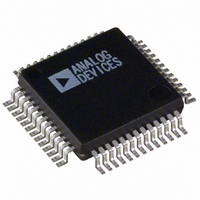AD1839AS-REEL Analog Devices Inc, AD1839AS-REEL Datasheet - Page 18

AD1839AS-REEL
Manufacturer Part Number
AD1839AS-REEL
Description
IC CODEC 2ADC/6DAC 24 BIT 52MQFP
Manufacturer
Analog Devices Inc
Type
Stereo Audior
Datasheet
1.AD1839AS-REEL.pdf
(24 pages)
Specifications of AD1839AS-REEL
Rohs Status
RoHS non-compliant
Data Interface
Serial
Resolution (bits)
24 b
Number Of Adcs / Dacs
2 / 6
Sigma Delta
Yes
S/n Ratio, Adcs / Dacs (db) Typ
105 / 108
Dynamic Range, Adcs / Dacs (db) Typ
105 / 108
Voltage - Supply, Analog
4.5 V ~ 5.5 V
Voltage - Supply, Digital
4.5 V ~ 5.5 V
Operating Temperature
-40°C ~ 85°C
Mounting Type
Surface Mount
Package / Case
52-BQFP
AD1839
CONTROL/STATUS REGISTERS
The AD1839 has 13 control registers, 11 of which are used to set
the operating mode of the part. The other two registers, ADC
Peak 0 and ADC Peak 1, are read-only and should not be pro-
grammed. Each of the registers is 10 bits wide with the exception
of the ADC peak reading registers, which are six bits wide. Writing
to a control register requires a 16-bit data frame to be transmit-
ted. Bits 15 to 12 are the address bits of the required register.
Bit 11 is a read/write bit. Bit 10 is reserved and should always
be programmed to 0. Bits 9 to 0 contain the 10-bit value that is
to be written to the register or, in the case of a read operation,
the 10-bit register contents. Figure 3 shows the format of the
SPI read and write operation.
DAC CONTROL REGISTERS
The AD1839 register map has eight registers that are used to
control the functionality of the DAC section of the part. The
function of the bits in these registers is discussed below.
Sample Rate
These bits control the sample rate of the DACs. Based on a
24.576 MHz IMCLK, sample rates of 48 kHz, 96 kHz, and
192 kHz are available. The MCLK scaling bits in ADC Control 3
should be programmed appropriately, based on the master clock
frequency.
Power-Down/Reset
This bit controls the power-down status of the DAC section.
By default, normal mode is selected, but by setting this bit, the
digital section of the DAC stage can be put into a low power
mode, thus reducing the digital current. The analog output
section of the DAC stage is not powered down.
DAC Data-Word Width
These two bits set the word width of the DAC data. Compact
disc (CD) compatibility may require 16 bits, but many modern
digital audio formats require 24-bit sample resolution.
DAC Data Format
The AD1839 serial data interface can be configured to be com-
patible with a choice of popular interface formats, including I
LJ, RJ, or DSP modes. Details of these interface modes are given
in the Serial Data Ports section of this data sheet.
De-emphasis
The AD1839 provides built-in de-emphasis filtering for the
three standard sample rates of 32.0 kHz, 44.1 kHz, and 48 kHz.
Mute DAC
Each of the six DACs in the AD1839 has its own independent
mute control. Setting the appropriate bit will mute the DAC
output. The AD1839 uses a clickless mute function that attenu-
ates the output to approximately –100 dB over a number of cycles.
Stereo Replicate
Setting this bit copies the digital data sent to the stereo pair
DAC 1 to the three other stereo DACs in the system. This
allows all three stereo DACs to be driven by one digital data
stream. Note that in this mode, DAC data sent to the other
DACs is ignored.
2
S,
–18–
DAC Volume Control
Each DAC in the AD1839 has its own independent volume
control. The volume of each DAC can be adjusted in 1024 linear
steps by programming the appropriate register. The default
value for this register is 1023, which provides no attenuation,
i.e., full volume.
ADC CONTROL REGISTERS
The AD1839 register map has five registers that are used to
control the functionality and read the status of the ADCs. The
function of the bits in each of these registers is discussed below.
ADC Peak Level
These two registers store the peak ADC result from each channel
when the ADC peak readback function is enabled. The peak
result is stored as a 6-bit number from 0 dB to –63 dB in 1 dB
steps. The value contained in the register is reset once it has
been read, allowing for continuous level adjustment as required.
Note that the ADC peak level registers use the six most signifi-
cant bits in the register to store the results.
Sample Rate
This bit controls the sample rate of the ADCs. Based on a
24.576 MHz IMCLK, sample rates of 48 kHz and 96 kHz are
available. The MCLK scaling bits in ADC Control III should be
programmed appropriately based on the master clock frequency.
ADC Power-Down
This bit controls the power-down status of the ADC section and
operates in a similar manner to the DAC power-down.
High-Pass Filter
The ADC signal path has a digital high-pass filter. Enabling this
filter will remove the effect of any dc offset in the analog input
signal from the digital output codes.
ADC Data-Word Width
These two bits set the word width of the ADC data.
ADC Data Format
The AD1839 serial data interface can be configured to be com-
patible with a choice of popular interface formats, including I
LJ, RJ, or DSP modes.
Master/Slave Auxiliary Mode
When the AD1839 is operating in the auxiliary mode, the
auxiliary ADC control pins, AUXBCLK and AUXLRCLK,
that connect to the external ADCs can be set to operate as a
master or slave. If the pins are set in slave mode, one of the
external ADCs should provide the LRCLK and BCLK signals.
ADC Peak Readback
Setting this bit enables ADC peak reading. See the ADC section
for more information.
REV. B
2
S,













